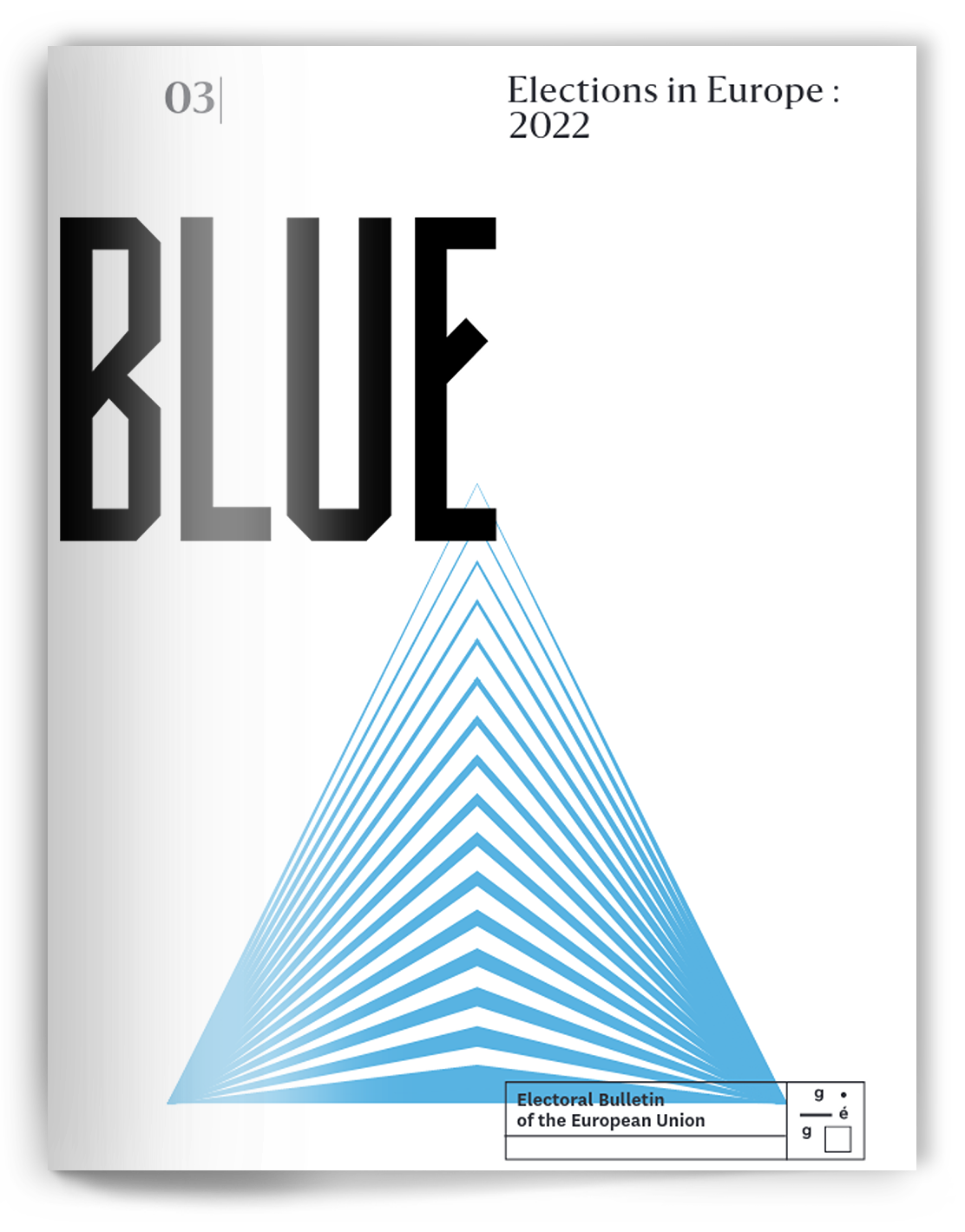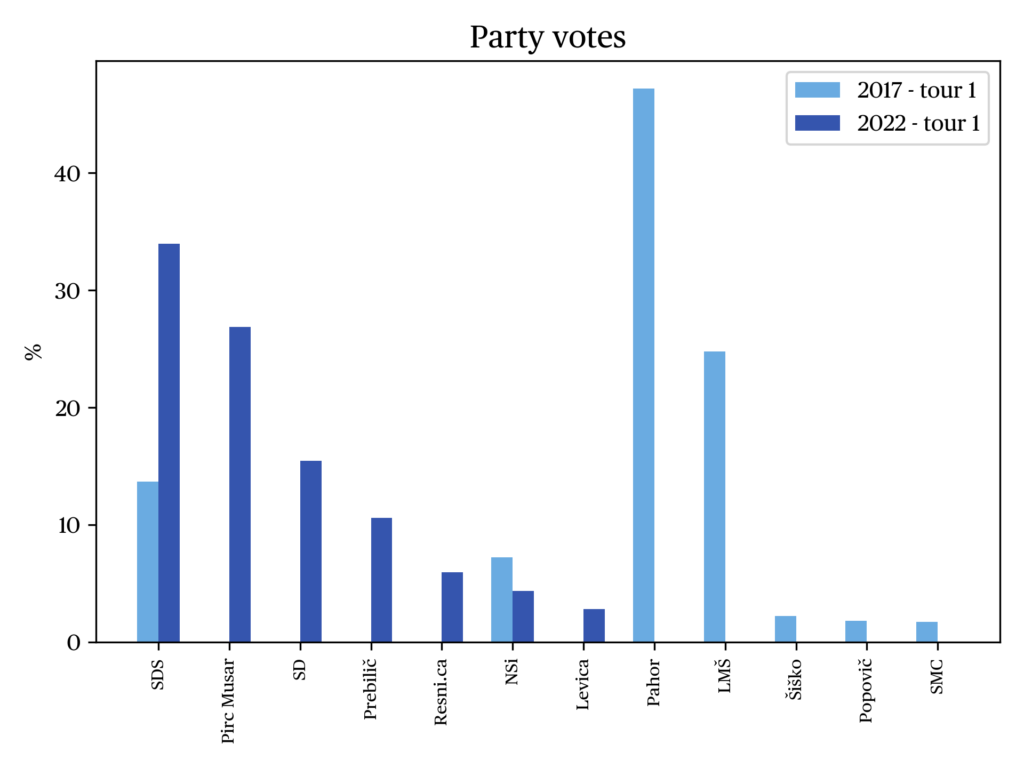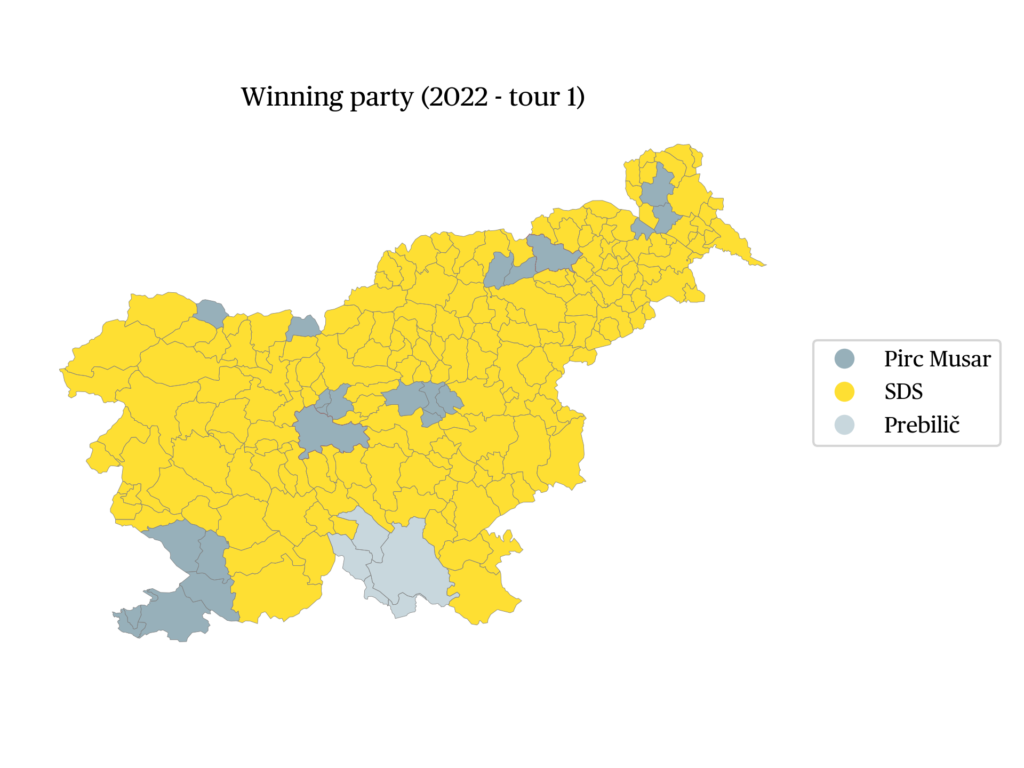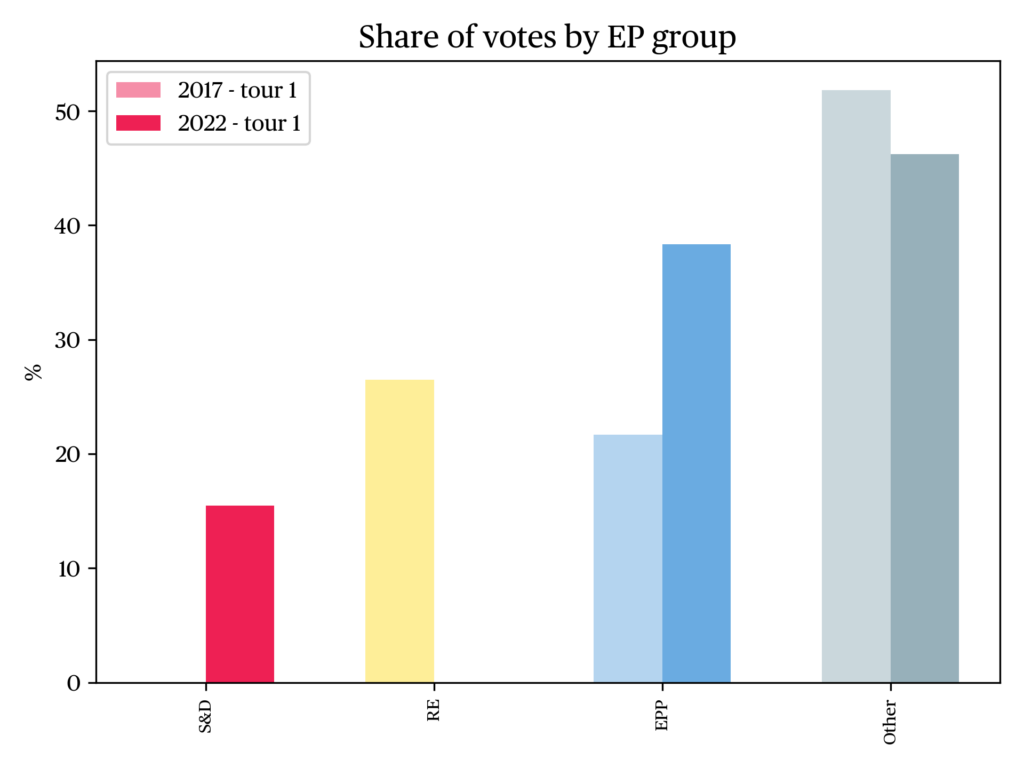Presidential election in Slovenia, 23 October 2022
Issue
Issue #3Auteurs
Meta Novak , Damjan Lajh
Issue 3, March 2023
Elections in Europe: 2022
Introduction
Although Slovenia has a parliamentary political system, the President of the Republic is elected in direct elections by secret ballot. Nevertheless, the presidential elections are seen as less important than general elections due to the limited area of the President’s constitutionally determined functions and responsibilities. The main attributions of the President include representative and protocol functions, and being the Commander-in-Chief of the defence forces. Other powers of the President of the Republic include announcing parliamentarian elections; promulgating laws after their adoption; appointing and recalling ambassadors; issuing instruments of ratification; deciding on pardons; awarding honorary titles; expressing an opinion on an individual issue at the request of the National Assembly; proposing a candidate for Prime Minister; nominating judges of the Constitutional Court and performing other duties determined by the constitution (Article 107 of the Constitution). In view of the duties and powers of the President of the Republic, his role is often seen as a mainly protocolary one (e-uprava, n.d.).
The President can serve at most two consecutive mandates, with each term lasting five years. Elections to the Presidency of the Republic are announced by the Speaker of the National Assembly.
The lower importance of presidential elections in the eyes of voters is evident mostly from voters turnout at the elections. Although electoral participation has been tendentially dropping for all types of elections, the turnout at the presidential elections is generally lower than the turnout at national parliamentary elections. In the first presidential elections in 1992, the voters turnout was very high, at almost 86%. At the elections in 1997 and in 2002 it was still around 70%. In 2007 it dropped below 60%, while at the 2012 elections it dropped even below 50%. In 2022, when it was clear that voters would elect a new president because the current president, Borut Pahor, was already serveing his second term, the turnout increased a little over 50%. This year’s election was the only one that took place in the same year as a parliamentary election, which might have generated a more heated climate and motivated additional voters to cast their ballot.
The Presidential election takes place in two rounds. If none of the candidates gathers more than 50% of valid votes, a second round of voting is organised between the two candidates that gathered the highest share of votes. For this reason, the winner of the election is usually not the candidate who gathered the most votes in the first round, but rather the candidate who was more acceptable for voters who originally gave their vote to a candidate not among the top two candidates in the first round. Only the first president of Slovenia, Milan Kučan, was elected in the first round of voting in both of his terms. He was able to gather more than 50% of the vote despite the number of other competing candidates.
Slovenian voters are frequently split between a centre-right and a centre-left option, with the centre-left presenting a slight majority. The main cleavage in Slovenia could be named traditional–modern or libertarian–authoritarian. The communism-anticommunism cleavage is closely connected to developments during World War II, and importantly overlaps with the libertarian-authoritarian cleavage (Krašovec & Novak, 2021). According to public opinion data, a higher share of Slovenian voters position themselves on the left side of the ideological spectrum. In 2021, 29.1 percent of respondents positioned themselves on the left, 24 percent in the centre and 22.6 percent on the right (Hafner-Fink, Broder & Doušak, 2020). Higher support for centre-left and left parties is also evident from election results in 2022, where the left-wing political parties who entered the parliament together gathered 45.6% of the vote (Novak & Lajh, 2022).
The 2022 presidential election was specific in three respects: for the first time, a female president was elected; the ring-wing candidate gathered the highest support among right-wing candidates with respect to previous elections; the winning candidate entered the electoral campaign as an independent and was not supported (in the first round ) by any political party. We will continue by reviewing the results, focusing on the candidates and their performance at the elections.
Results
First round of elections
While in parliamentary elections, it is quite common that voters resort to strategical voting by supporting that they deem most likely to win and form the government — which was the case in the 2022 parliamentary elections in Slovenia (Novak & Lajh, 2022) —, due to the two-round system of presidential elections voters in the first round usually support the candidate that they prefer, even if she/he will not gather sufficient amount of votes to enter the second round. In the second round, voters then decide to support their best, or least bad, option. The votes in the first round are thus likely to be dispersed among many candidates.
In the first round of the presidential election, held on 23 October 2022, seven candidates competed. None of the candidates gathered more than 50% of the vote, and a second round of elections needed to be organised. The candidates were different than those competing at the 2017 election, when seven candidates were also running for the position. Only three political parties — the Slovenian Democratic Party (SDS), New Slovenia – Christian democracy (NSi) and the Slovenian Democrats (SD) — ran with candidates in both elections.
In the first round, Anže Logar received the highest percentage of votes — 33.96%. He has been a member of the National Assembly, and despite being a highly visible member of the SDS party (and even the chairman of the party’s program council), at the elections he ran as an independent candidate, he won in a majority of municipalities, achieving particularly good result in rural areas. This result also meant that the SDS as a party performed better than at the previous 2017 Presidential election, when they received 13.68% of votes, and even better than at he parliamentary election held earlier in 2022, when they received 23.48% of votes (DVK, 2022). One of the main reasons Logar ran as an independent candidate was that he also wanted to attract voters that position themselves against the SDS party, and, more specifically, again their controversial leader Janez Janša. In the pre-election debates, his status as a party rather than an independent candidate was challenged. Despite widespread doubts about the independence of his candidacy, this ambiguity has probably contributed to his success.
The candidate to announce her participation in the election was Nataša Pirc Musar, a former journalist, information Commissioner and, at the time of her nomination, a lawyer in her private firm. Together with her husband, she owns several companies. She ran as an independent candidate, but received support from the two former presidents Milan Kučan and Danilo Türk. She was able to receive the second highest share of votes (26.87%) performing better in the urban cities of Ljubljana, Maribor, Koper and Murska Sobota, and surrounding municipalities. During the election campaign, she was confronted about the personal assets that the holds together with her husband, as well as about her tax bills (Vrkapić & Božič, 2022). She denied all the allegations and was even able to overcome them, although property issues have been important to Slovenian voters in the past. In the second round of the election, her candidacy was immediately supported by Robert Golob, president of the Freedom Movement Party (GS) (STA, 2022), as well as by the SD (Dnevnik, 2022) — giving her support from the two biggest coalition parties in the National Assembly.
Milan Brglez, member of the European Parliament, former president of the National Assembly and a university professor, was the official candidate of the SD and GS parties in the first round of the election. Initially, he was a candidate for the SD party, but received GS’s support once Marta Kos, a former GS vice-president , decided not to run for president due to personal reasons. The 15.41% of the vote that Brglez received was, in eyes of many, a defeat of the winning party at the parliamentary election, and, at the same time, of the entire coalition. Compared to the 2017 presidential election, the SD performed worse — Borut Pahor, the Slovenian president in the previous two terms from 2012 to 2022, was a member of the SD.
Vladimir Prebilič, an independent candidate, exceeded most analysts’ expectations, receiving 10.66% of the vote. He is a university professor and the mayor of Kočevje municipality. His candidacy was supported by the new, extraparliamentarian Green party Vesna, which was established by civil society actors. Through his candidacy, he supported green ideas and tried to present himself as a bridging actor that would be able to overcome the split between the political left and right. After the first round of elections, he even refused to support any of the first two candidates (N1, 2022). While at first public opinion data showed low public support for his candidacy (Žurnal24, 2022), he was able to convince voters in pre-election TV debates, using his rhetorical skills to gather more support. He performed especially well in his local environment, in the municipalities of Kočevje, Ribnica, Loški potok, Kostel and Osilnica, where he even received the most votes.
Sabina Senčar, a doctor and gynaecologist, also run with the support of an extraparliamentary party. Namely, she received her support from the party Resni.ca. This party is slightly controversial as its leader was behind the organisation of anti-covid protests in Automn 2021, which turned violent on some occasions (Novak, 2022). At the parliamentary election, Resni.ca received a surprising 2.86%. This was not enough to enter the parliament, since the minimal threshold is 4%, but the party was now entitled to financial support for the entire term. Senčar also performed better than expected and came at the fifth place with 5.96% of the vote. Resni.ca analyzed this performance as reflecting increasing support for their party (Bitenc, 2022).
Janez Cigler Kralj and Miha Kordiš, who where both party candidates, obtained disappointing results, being able to gather only few votes. Janez Cigler Kralj is a member of the NSi party and former minister. He obtained only 4.35% of the vote, which was also disappointment for the party. For the second round of elections, NSi decided to support the SDS candidate Anže Logar (MMC RTV SLO, 2022). This was expected since both parties have often collaborated In the past.
Miha Kordiš is a member of the government coalition party, the Left. He received the least votes — 2.80%. Since his party’s positions are often radical, he did not expect high support and was satisfied with the content he brought into the pre-election campaign (Kralj, 2022). He received votes mostly from urban areas, while Janez Cigler Kralj mostly received votes from rural areas. Nevertheless, the representatives of these two parliamentary parties were expected to perform better at the elections.
Second round of elections
The second round of elections was organised on Sunday, 13 November 2022. The second round is organised only between the two candidates who received the most votes in the first round. These were Anže Logar and Nataša Pirc Musar. Although Logar received more votes in the first round, in the second round he lost against Pirc Musar. It can be suggested that voters did not decide primarily between two candidates, but between left-wing and right-wing political options (Zavrtanik, 2022) or even on the basis of anti-Janša voting (Esih, 2022). Given that more Slovenians position themselves on the left of the political spectrum (Novak and Lajh, 2022), it was expected that Pirc Musar would win the election. This indeed happened, as Pirc Musar received 53.89% of the vote. She was elected mostly thanks to voters from urban areas in the West and North of Slovenia, where public support for the current government is also higher. This was the first victory of a female and independent candidate in a presidential election since the foundation of the independent Slovenian state 30 years ago. Logar received 46.11% of the vote and received support mostly from rural areas. The voters’ turnout was 53.60%, which was higher by 2 pp in comparison to the first round. In both the first and second rounds, invalid and blank ballot papers were more common in the Western part of Slovenia. However, the share of invalid ballots was higher in the second round.
Conclusion
The 2022 presidential election was in many ways different from the previous ones. Given that current president Borut Pahor already served two mandates and a new president was about to be elected, the outcome of the election was open, and parties searched for candidates that could gather broad support and potentially win. In many ways, Anže Logar tried to address the voters in a similar manner as his predecessor, by joining local events and sport events. Janez Cigler Kralj even used the slogan “One of us”. At the end, it seemed that these presidential elections were mostly a competition between the left and the right, confirming the high level of political and social polarisation of Slovenian society. After the results of the first round, Nataša Pirc Musar even announced that this presidential election would be a “clash of values” and thus clearly emphasized the different political positioning of the two candidates (MMC RTVO SLO, 2022b). This was also the impression given by the winning parliamentary party GS, which gave their support to Nataša Pirc Musar and “adopted” her as their candidate (because of her left-wing orientation) as soon as it became clear that their official party candidate would not enter to the second round. This led to the election of the first female Slovenian president, and to the first victory of an independent candidate in Slovenian history, despite Pirc Musar facing many allegations during the campaign regarding her salary and personal assets, issues that played an important role in previous presidential elections.



References
Bitenc, U. (2022, 23 October). Senčarjeva na petem mestu: ‘Odlično’. 24ur.com.
Dnevnik (2022, 28 October). SD v drugem krogu predsedniških volitev podpira Natašo Pirc Musar. Dnevnik.
Državna volilna komisija (DVK). Volitve in referendumi.
e-Uprava (n.d.). Državna ureditev: Predsednik republike — področje delovanja in pristojnosti [State regulation: President of the Republic — area of activity and powers]. Retrieved 11.12.2022.
Esih, U. (2022, 8 November). Petnajst let glasovanj proti SDS in Janezu Janši. Delo.
Hafner-Fink, M., Broder, Ž., Doušak, M. & others (2020). Slovensko javno mnenje 2020/1 — Poročilo o izvedbi raziskave in sumarni pregled rezultato [Slovenian Public Opinion 2020/1 — Report on the Implementation of the Survey and a Summary of the Results]. Ljubljana: Center za raziskovanje javnega mnenja in množičnih komunikacij, Univerza v Ljubljani, Fakulteta za družbene vede.
Kralj, A. (2022, 23 October). Kordiš na zadnjem mestu, Mesec: Številke niso bistvene. 24ur.com.
Krašovec, A. & Novak, M. (2022). Democracy, Party Politics and Relations with the EU. Southeast Europe in Focus 2: 16-32.
MMC RTV SLO (2022, 26 October). NSi bo v 2. krogu podprl Logarja. MMC RTV SLO.
N1 (2022, 23 October). Vladimir Prebilič: “Ljudje imajo vedno prav”. N1.
Novak, M. (2022). Slovenia. Nations in Transit. Freedom House.
Novak, M. & Lajh, D. (2022). Parliamentary Elections in Slovenia: Strategic Vote for Left-wing Politics and against the Right-wing Government. Südosteuropa Mitteilungen 4: 7-19.
STA (2022, 23 October). Golob: Poraženca bomo spoznali v drugem krogu, Svoboda bo podprla Pirc Musarjevo. STA.
Zvrtanik, M. (2022, 13 November). Ob glasovih za Natašo Pirc Musar je del volivcev glasoval proti Logarju, del pa proti Pahorju. RTV SLO.
Žurnal24 (2022, 8 October). Vse kaže na tesen boj. Žurnal24.
citer l'article
Meta Novak, Damjan Lajh, Presidential election in Slovenia, 23 October 2022, Mar 2023, 140-144.
à lire dans cette issue
voir toute la revue





